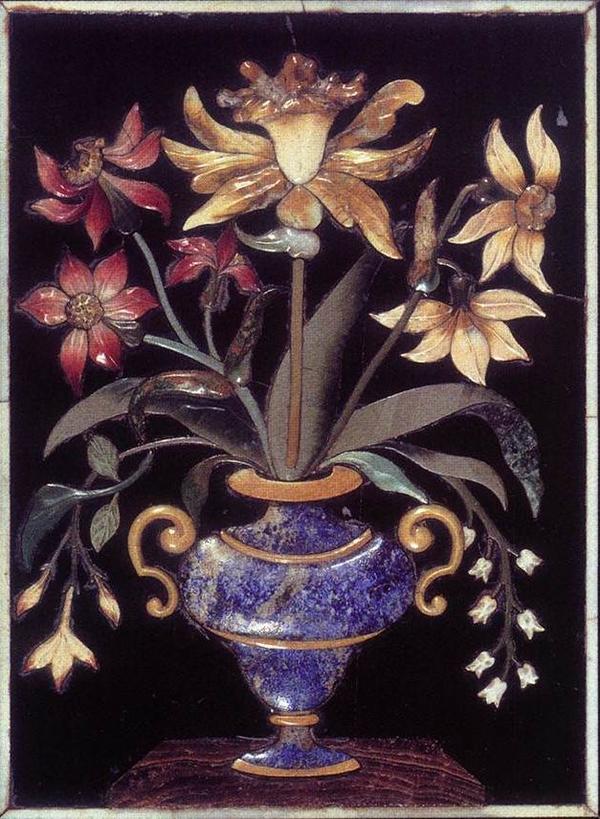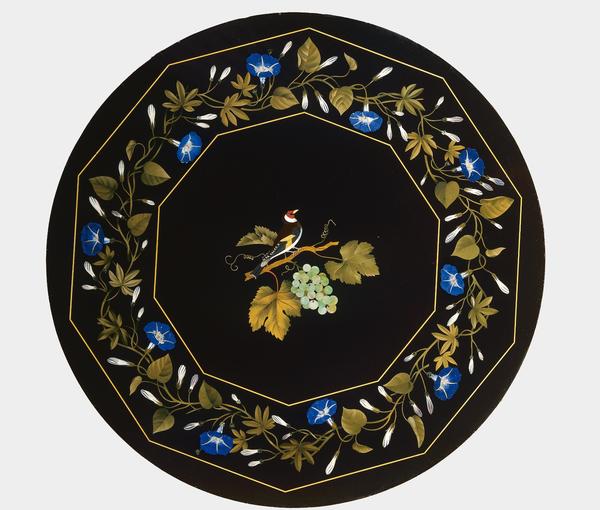The table with mosaic tabletop was made within the period between the 18th and early 19th centuries. The base of the table was made in a workshop in France, and the top with a Florentine mosaic was made by masters from Italy.
1 / 2
Table with mosaic tabletop
Время создания
The 18th - beginning of the 19th century
Размер
85.5x94.5 x 104.5 cm
Техника
Tabletop: Florentine mosaic - marble, malachite, azure, fluorite, bakelite filling (amber and soot)
Коллекция
Выставка
8
Открыть в приложении#1
Unknown author
Table with mosaic tabletop
#2
#3
An unknown Italian author cut the mosaic of valuable species of stones. He processed each piece of marble, malachite, azure and fluorite so that no joints or height changes were noticeable after the fitting. The master made the dark background for the bird of a secret compound - bakelite filling. For a long time its ingredients were known only to Florentines. Now researchers know that the filling is made of amber and soot. The master would apply the mixture while it was liquid. When it froze, it became as solid as a stone. The finished filling is similar to marble in terms of glitter, as well to the touch.
#4
It is difficult to say how much time it took to the artist to complete the work. But it is known that making of one square meter of such a mosaic could take many months, if not a year of labor. Masters mosaicists took into account the color of the stone, the frequency of layers, inclusions, coloured spots in the material. At that, inclusions were not considered a flaw - they were valued as a pictorial feature. The cracks had to be embedded into the picture. Russian masters called this to give strength to the stone that is, to allow every speck to prove itself in the overall composition. Masters would develop the volumes and tonal transitions, showed shadows on objects.
#5
The work would usually be assembled according to a sketch. The master would prepare the stones on the basis of the sketch. Artists would decorate with mosaic tabletops, dressers, caskets. Products were in demand with the nobility: polished stones did not fade, nor crumble. Besides, because of the uniqueness of the natural pattern of the stones, it was impossible to make an exact copy of the mosaic.
Mosaic from Florence. 1650 Unknown author
#6
The Florentine mosaic appeared in Italy during the Renaissance. It appeared in the second half of the 16th century. The first mosaics were created in Florence, in a mosaic workshop owned by the Medici family. It was also in that workshop where they started to use bakelite filling. The workshop retained its fame until the collapse of the Duchy of Tuscany, its creativity inspired other European states to establish such workshops of their own. In Russia the center of the mosaic art was the Peterhof lapidary factory.
Florentine mosaic Goldfinch on a branch. Ivan Sokolov. 1848-1850
#7
The table with Florentine mosaics was the first exhibit in the collection of the Yaroslavl Museum of Fine Arts. It used to belong to Count Vasily Kochubey. In the description of furniture dated January 1893 conducted by the Kochubey family it was stated that previously the object had been owned by A. Demidov, Prince of San Donato.
#8
Yaroslavl Museum of Fine Arts
читать дальшескрыть
00:00
00:00
1x
Table with mosaic tabletop
Время создания
The 18th - beginning of the 19th century
Размер
85.5x94.5 x 104.5 cm
Техника
Tabletop: Florentine mosaic - marble, malachite, azure, fluorite, bakelite filling (amber and soot)
Коллекция
Выставка
8
Открыть в приложении
Поделиться




